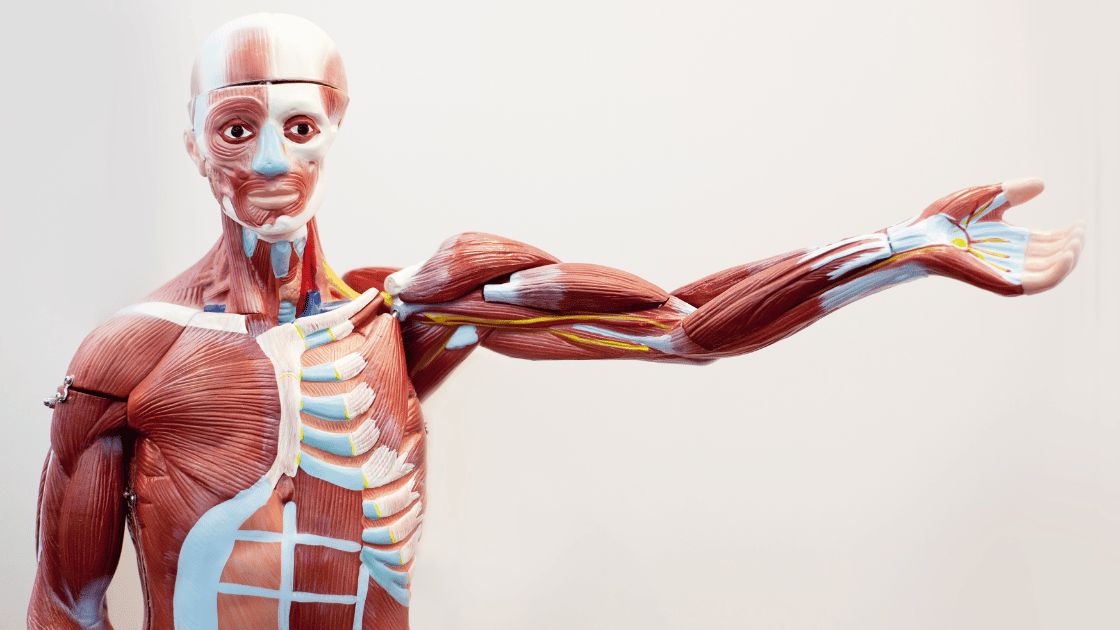What Are Fast-Twitch Muscle Fibers? A Comprehensive Guide

Fast-twitch muscle fibers are key players in supporting high-intensity activities like heavy lifting and sprinting. Unlike slow-twitch muscle fibers, which are built for endurance activities, fast-twitch fibers are designed for quick bursts of intense energy. These muscle fibers contract rapidly, making them essential for explosive movements in various sports.
In this article, we’ll explore everything you need to know about fast-twitch muscle fibers:
- What they are and how they differ from slow-twitch fibers
- The different types of fast-twitch fibers
- Why they’re important for athletes
- Effective training methods to develop these important muscle fibers
By the end of this article, you’ll have a solid understanding of fast-twitch muscle fibers and how to train them effectively, so you can boost your athletic performance and overall fitness.
Understanding Fast-Twitch Muscle Fibers
Fast-twitch muscle fibers, also known as Type II muscle fibers, play a crucial role in athletic performance. These muscle fibers are responsible for generating quick and powerful contractions, making them essential for activities that require explosive strength and speed. In contrast to slow-twitch muscle fibers, which are built for endurance activities, fast-twitch muscle fibers are designed for high-intensity work such as heavy lifting and sprinting.
Key Points about Fast-Twitch Muscle Fibers
Here are some key points to understand about fast-twitch muscle fibers:
Definition
Fast-twitch muscle fibers are a type of skeletal muscle fiber that contract rapidly and forcefully. They have a larger diameter compared to slow-twitch fibers, giving them the ability to generate more forceful contractions.
Characteristics
Fast-twitch muscle fibers have several distinct characteristics that differentiate them from slow-twitch fibers:
- They contain fewer mitochondria, which are the powerhouses of the cell responsible for aerobic energy production.
- They have a lower capillary density, limiting their oxygen supply during intense exercise.
- They rely on anaerobic metabolism for energy synthesis, using stored phosphocreatine and glycogen reserves rather than oxygen.
Energy Synthesis
Fast-twitch muscle fibers primarily rely on the anaerobic process to synthesize energy. During high-intensity activities like weightlifting or sprinting, the body cannot supply enough oxygen to meet the muscles’ demands. As a result, these muscles tap into their stored energy sources to produce ATP (adenosine triphosphate) quickly.
The anaerobic process involves breaking down phosphocreatine and glycogen stored within the muscles to produce ATP without the need for oxygen. This process is efficient in providing short bursts of energy but can only be sustained for a limited duration due to the limited availability of stored energy.
Understanding the characteristics and energy synthesis process of fast-twitch muscle fibers is crucial for effective training. By targeting these muscle fibers specifically, athletes can enhance their explosive strength, power, and overall performance in activities that require short bursts of intense effort.
Types of Fast-Twitch Muscle Fibers
Fast-twitch muscle fibers can be further classified into two main subtypes: Type IIa and Type IIx. These subtypes have distinct characteristics and play different roles in specific athletic activities.
Type IIa Muscle Fibers
Type IIa muscle fibers are also known as intermediate fast-twitch fibers. They possess a combination of characteristics from both slow-twitch (Type I) and fast-twitch (Type IIx) muscle fibers. Here are some key points about Type IIa fibers:
- Role in Athletic Activities: Type IIa fibers are involved in sustained power activities that require a balance between strength and endurance. These activities typically involve moderate to high-intensity efforts performed over a longer duration. Examples include middle-distance running, cycling, and swimming events.
- Characteristics: Type IIa fibers have a higher oxidative capacity compared to Type IIx fibers, which means they can generate energy through both aerobic and anaerobic processes. They contract more slowly than Type IIx fibers but are still faster than slow-twitch fibers.
- Training Techniques: To target Type IIa muscle fibers, incorporating exercises with moderate loads and repetitions can be effective. Examples include performing 8-12 reps per set with around 70-80% of your one-repetition maximum (1RM) for exercises like squats, lunges, or bench presses.

Type IIx Muscle Fibers
Type IIx muscle fibers, also known as fast glycolytic fibers, are the true “explosive” fast-twitch fibers. Here’s what you need to know about them:
- Role in Athletic Activities: Type IIx fibers are primarily responsible for short-duration, maximal efforts requiring explosive power and strength. Activities such as sprinting, jumping, and heavy weightlifting rely heavily on the recruitment of these muscle fibers.
- Characteristics: Type IIx fibers have a low oxidative capacity and rely predominantly on anaerobic energy synthesis. They contract rapidly and generate high force output but fatigue quickly.
- Training Techniques: To target Type IIx muscle fibers, incorporating exercises with heavy loads and low repetitions is essential. These exercises should focus on maximizing force production and power output. Examples include performing 1-5 reps per set with 85-95% of your 1RM for exercises like deadlifts, cleans, or snatches.
Understanding the characteristics and roles of each subtype allows athletes to tailor their training programs to meet specific performance goals. By incorporating exercises that target both Type IIa and Type IIx muscle fibers, athletes can develop a well-rounded muscular foundation for their respective sports.
It’s important to note that individuals may have a genetic predisposition towards a higher proportion of one subtype over the other. However, through targeted training, it is possible to enhance the function and development of both subtypes, leading to improved athletic performance.
Why Training Fast-Twitch Muscle Fibers is Important for Athletes
Developing strong and explosive fast-twitch muscle fibers is crucial for athletes who want to perform at their best in sports that require high-intensity efforts. These muscle fibers are responsible for generating power and speed, which are essential for explosive movements like sprinting, jumping, and throwing. Here’s why training fast-twitch muscle fibers is vital for athletic performance:
1. Power and Explosiveness
Fast-twitch muscle fibers produce quick and forceful contractions, making them important for explosive movements. By training these fibers, athletes can:
- Improve their ability to generate power
- Increase their explosiveness on the field or court
2. Improved Speed
Speed plays a significant role in many sports, including track and field events and team sports like soccer and basketball. Fast-twitch muscle fibers are directly involved in generating rapid contractions for quick bursts of speed. By training these fibers, athletes can:
- Enhance their acceleration
- Improve their overall speed
- Gain an advantage over their opponents
3. Enhanced Strength
Although slow-twitch muscle fibers are mainly responsible for endurance activities, fast-twitch muscle fibers contribute significantly to overall strength. By targeting these fibers through specific training methods such as resistance exercises with heavy weights or powerlifting movements, athletes can:
- Increase their overall strength capacity
4. Sport-Specific Performance
Different sports place different demands on the body’s muscle fiber types. For example:
- Weightlifting or shot put requires a higher proportion of Type IIx fast-twitch muscle fibers because of the brief yet intense bursts of power needed.
- Basketball or soccer relies more on Type IIa fast-twitch muscle fibers for repeated explosive movements over a longer duration.
By understanding the specific demands of their sport and training accordingly, athletes can optimize their performance in their chosen discipline.
To maximize the development of fast-twitch muscle fibers and improve athletic performance, it is important to incorporate targeted training methods into a well-rounded workout routine. In the next section, we will explore various training methods that specifically stimulate fast-twitch muscle fiber development, allowing athletes to optimize their performance and reach their full potential.
Training Methods to Enhance Fast-Twitch Muscle Fiber Development
Fast-twitch muscle fibers are crucial for explosive movements and high-intensity activities. To enhance the development of these muscle fibers, incorporating specific training methods into your workout routine is essential.
1. Sprinting
Benefits of Sprinting
Sprinting is an excellent way to stimulate fast-twitch muscle fibers due to its explosive nature. It helps improve anaerobic capacity, speed, and power, all of which are directly linked to fast-twitch muscle fiber development. Additionally, sprinting can enhance overall athletic performance by promoting coordination and agility.
Guidelines for Structuring Sprint Workouts
Incorporating sprint workouts into your training regimen should be done with caution to prevent injuries and maximize benefits. Here’s how you can structure your sprint workouts:
- Warm-up: Start with a proper warm-up to prepare your muscles for the intense activity. This can include dynamic stretches, mobility exercises, and light jogging.
- Interval Training: Consider implementing interval training, alternating between short sprints and recovery periods to optimize fast-twitch muscle fiber stimulation. For example, you can sprint at maximum effort for 20 seconds followed by 40 seconds of rest or light jogging. Repeat this cycle for a specific number of sets.
- Progressive Overload: Gradually increase the intensity and duration of sprints as your body adapts to the demands. This can be done by reducing the rest periods between sprints, increasing the number of sets, or extending the sprint distance.
Sprinting not only targets fast-twitch muscle fibers effectively but also contributes to overall cardiovascular fitness, making it a valuable addition to any training program focused on enhancing explosive power and speed.
2. Powerlifting
Powerlifting is an effective training method for developing fast-twitch muscle fibers. It involves heavy lifting and compound movements like deadlifts and squats, which are great for building strength and activating these specific muscle fibers.
How Powerlifting Helps Develop Fast-Twitch Muscle Fibers
Powerlifting exercises contribute to fast-twitch muscle fiber development in two main ways:
- Increased Muscle Fiber Recruitment: The heavy loads used in powerlifting put a significant demand on your muscles, leading to more recruitment and activation of fast-twitch muscle fibers during the movement. This results in greater strength gains.
- Explosive Power Requirement: Powerlifting movements, such as deadlifts and squats, require explosive power to lift the weight or perform the exercise. This explosive power heavily relies on the activation of fast-twitch muscle fibers, as they generate high force levels within a short time frame. Regularly including powerlifting in your workouts can improve your explosive strength and enhance the efficiency of your fast-twitch muscle fibers in generating power.

Tips for Incorporating Powerlifting into Your Routine
To effectively include powerlifting exercises in your workout plan, follow these guidelines:
- Focus on Compound Movements: Make compound exercises like deadlifts, squats, bench press, and overhead press the core of your powerlifting routine. These movements engage multiple muscle groups simultaneously, leading to overall strength development.
- Gradually Increase Load: Start with lighter weights and progressively add more weight as you become comfortable with the exercises. This gradual increase in intensity ensures that you continually challenge your muscles and stimulate further adaptation.
- Controlled Eccentric Phase: Pay attention to the lowering phase of each lift (also known as the eccentric phase). Lowering the weight under control helps involve more fast-twitch muscle fibers and enhances overall muscle control and stability.
- Train with Intensity: Powerlifting involves lifting heavy weights at high intensity. Push yourself to lift weights that are challenging, while still maintaining proper form and technique. This level of intensity stimulates the recruitment and activation of fast-twitch muscle fibers.
- Allow Ample Recovery Time: Given the significant stress powerlifting puts on your muscles, it’s crucial to allow enough rest and recovery between sessions for optimal muscle repair and growth. Aim for at least 48 hours of rest between powerlifting workouts.
The Benefits of Powerlifting for Fast-Twitch Muscle Fiber Development
By including powerlifting exercises in your training routine, you can effectively target and develop your fast-twitch muscle fibers, leading to:
- Improved overall strength
- Enhanced explosive power, which is important for activities requiring short bursts of intense effort
Remember to start with lighter weights, gradually increase the load, and prioritize proper form and technique to make the most out of powerlifting for fast-twitch muscle fiber development.
3. Resistance Training with Max Repetition and Weight
Resistance training with maximum repetition and weight is another effective method for targeting and developing fast-twitch muscle fibers. This type of training focuses on recruiting a high number of muscle fibers and challenging them to produce maximal force. Here’s why this training modality is beneficial for fast-twitch muscle fiber development:
1. Recruitment of fast-twitch muscle fibers
Resistance exercises performed with heavy weights and maximal effort require the activation of a greater number of muscle fibers, including the fast-twitch fibers. The high intensity and load placed on the muscles during these exercises stimulate the recruitment and activation of the powerful Type II muscle fibers.
2. Increased muscle strength
Resistance training with maximum repetition and weight is an excellent way to build overall strength. By consistently challenging your muscles with heavy loads, you stimulate their adaptation and growth, leading to increased strength. This is particularly important for athletes who rely on explosiveness and power in their respective sports.
3. Enhanced muscular power
Fast-twitch muscle fibers are responsible for generating explosive power during activities like sprinting, jumping, or throwing. By incorporating resistance training with maximum repetition and weight into your workout routine, you can improve the power-generating capacity of these muscle fibers. The heavy loads used in this type of training force the muscles to generate greater force output, translating into improved explosive power.
To effectively train fast-twitch muscle fibers through resistance training with max repetition and weight, consider incorporating the following exercises into your routine:
- Squats: This compound exercise targets multiple lower body muscles, including the quadriceps, hamstrings, and glutes. Performing squats with heavy weights challenges these muscles to generate maximum force, activating fast-twitch muscle fibers.
- Deadlifts: Deadlifts primarily target the posterior chain muscles such as the glutes, hamstrings, and lower back. By performing deadlifts with heavy weights, you can engage and strengthen the fast-twitch muscle fibers in these muscle groups.
- Bench Press: The bench press is a classic upper body exercise that primarily targets the chest, shoulders, and triceps. By using heavy weights and pushing for maximum repetitions, you can recruit and train the fast-twitch muscle fibers in these muscles.
- Overhead Press: This exercise focuses on developing shoulder and upper body strength. By performing the overhead press with heavy weights, you can activate the fast-twitch muscle fibers in the shoulders and arms.
Remember, when incorporating resistance training with maximum repetition and weight into your workout routine:
- Start with a weight that challenges you but allows for good form.
- Gradually increase the weight as your strength improves.
- Pay attention to proper technique to prevent injuries.
- Allow for adequate rest periods between sets to maximize recovery.
By including resistance training with maximum repetition and weight exercises in your workout routine, you can effectively target and develop your fast-twitch muscle fibers, leading to improvements in strength, power, and overall athletic performance.
4. Plyometric Exercises
Plyometric exercises are dynamic movements that enhance the power-generating capacity of fast-twitch muscle fibers. These explosive exercises focus on rapid stretching and contracting of muscles, promoting strength, speed, and agility. Here’s an overview of the various effective training modalities that specifically target fast-twitch muscle fibers through plyometric exercises:
Box Jumps
Box jumps involve explosively jumping onto a sturdy box or platform and then immediately jumping back down. This exercise requires maximal force production in a minimal amount of time, effectively engaging fast-twitch muscle fibers to generate power.
Medicine Ball Throws
Utilizing a medicine ball for overhead throws, chest passes, or rotational throws engages fast-twitch muscle fibers by requiring rapid and forceful movements. The explosive nature of these exercises promotes muscle power development.
Depth Jumps
Depth jumps involve stepping off a raised platform and immediately exploding upward upon landing. This movement pattern stimulates the stretch-shortening cycle of muscles, activating fast-twitch fibers to generate powerful jumps.
By incorporating plyometric exercises into your training regimen, you can effectively target and develop your fast-twitch muscle fibers to enhance explosive power and athletic performance.
Optimizing Rest and Recovery for Fast-Twitch Muscle Fiber Adaptation
Rest days and adequate muscle recovery play a crucial role in optimizing the development of fast-twitch muscle fibers. Here’s why:
- Optimal Muscle Repair: Adequate rest periods between intense training sessions allow your muscles, including fast-twitch fibers, to repair and grow effectively.
- Prevention of Overtraining: Overtraining can lead to fatigue, decreased performance, and increased risk of injury. Giving your body sufficient rest is essential for preventing overtraining.
- Hormonal Balance: Rest days help maintain a healthy hormonal balance, which is vital for muscle recovery and adaptation.
- Improved Performance: Proper rest and recovery contribute to improved overall performance during subsequent training sessions by ensuring that your muscles are well-rested and ready to perform at their peak.
By understanding the significance of rest and recovery in fast-twitch muscle fiber adaptation, you can enhance the effectiveness of your training regimen and achieve optimal results.

Preserving Fast-Twitch Muscle Fiber Function with Aging
As we get older, our fast-twitch muscle fibers naturally start to decline in both function and size. This decline can result in a decrease in explosive power, strength, and overall athletic performance. However, there are specific training methods that can help slow down this loss of fast-twitch muscle fibers and maintain their function.
Aging and Fast-Twitch Muscle Fibers
With age, our bodies tend to have fewer and smaller fast-twitch muscle fibers. This can lead to a decrease in power output and an increased risk of injuries, which can affect our athletic abilities and day-to-day activities.
Role of Strength Training
Strength training is key when it comes to preserving fast-twitch muscle fibers as we age. This type of training involves doing exercises with resistance that target these specific muscle fibers, which helps stimulate their growth and improve their function. By incorporating regular strength training into our routines, we can slow down the decline of fast-twitch muscle fibers and maintain their ability to generate power.
Mitigating Muscle Fiber Loss
To counteract the age-related decline of fast-twitch muscle fibers, it’s important to include exercises in our workouts that specifically activate these fibers. Some examples include:
- Explosive movements: These are exercises that require a quick burst of energy, like jump squats or medicine ball throws.
- Heavy resistance training: This involves lifting weights that are challenging for us, which helps recruit and strengthen our fast-twitch muscle fibers.
By incorporating these types of activities into our training regimen, we can stimulate the neural pathways associated with fast-twitch fibers and promote their activation and adaptation.
Balanced Training Approach
To effectively preserve the function of our fast-twitch muscle fibers as we age, it’s beneficial to take a well-rounded approach to our workouts. This can include:
- Strength training: Using resistance exercises to target fast-twitch muscle fibers.
- Sprinting: Incorporating short bursts of high-intensity running into our cardio routines.
- Powerlifting: Performing exercises like deadlifts and bench presses that focus on lifting heavy weights.
- Plyometric exercises: Adding in explosive movements like box jumps or burpees to improve power.
By combining these different training methods, we can address various aspects of muscle performance and contribute to overall muscular health and functionality.
By understanding how aging affects fast-twitch muscle fibers and implementing targeted training strategies, we can take proactive steps towards maintaining these important components of athletic performance as we get older.
Incorporating a Comprehensive Approach to Fast-Twitch Muscle Fiber Training
Fast-twitch muscle fibers are important for explosive movements and high-intensity activities. To train these fibers effectively, it’s best to use a combination of methods that target different aspects of their development. This will help athletes get the best results and improve their overall athletic performance.
How to incorporate a comprehensive approach to fast-twitch muscle fiber training:
- Try different exercises: Do a variety of exercises that specifically work on fast-twitch muscle fibers. This could include things like sprinting, powerlifting, plyometric exercises (jumping and hopping), and resistance training with heavy weights.
- Work all your muscles: While it’s important to focus on fast-twitch muscle fibers, you should also train other muscles in your body. This will help with overall strength and stability. So make sure to include exercises that target different muscle groups.
- Change up your training: Have a plan for your workouts that includes different levels of intensity and volume. This means doing some sessions that are harder and others that are easier. It’s important to give your muscles time to recover while still challenging them enough to grow stronger.
- Train for real-life movements: Include exercises that mimic the movements you do in everyday life or in your sport. This can help you take the strength you’ve gained from training and use it better when you’re actually doing activities.
Remember to customize your training program based on your own needs and get help from fitness experts if needed.
By using a comprehensive approach to fast-twitch muscle fiber training, athletes can improve their physical abilities, lower the risk of getting hurt, and perform better in activities that need quick power and speed.
Next Steps on Your Fast-Twitch Muscle Fiber Training Journey
Now that you have gained valuable insights into the world of fast-twitch muscle fibers and effective training methods, it’s time to take action and incorporate this knowledge into your fitness routine. Here are some key steps to consider as you embark on your fast-twitch muscle fiber training journey:
Create a Well-Rounded Training Program
Integrate a variety of exercises targeting different aspects of fast-twitch muscle fiber development, including:
- Sprinting
- Powerlifting
- Resistance training
- Plyometric exercises
Seek Professional Guidance
If you are new to fast-twitch muscle fiber training or have specific fitness goals in mind, consider consulting a qualified strength and conditioning professional. They can provide personalized guidance and help tailor a training program to suit your individual needs.
Monitor Your Progress
Keep track of your performance and progress over time. This could involve:
- Tracking your sprint times
- Increasing weights in powerlifting exercises
- Improving your overall explosive strength through plyometrics
Prioritize Rest and Recovery
Remember that adequate rest between intense training sessions is crucial for optimal muscle repair and growth, including the development of fast-twitch muscle fibers.
By taking these steps and staying committed to your training program, you can maximize the development of your fast-twitch muscle fibers and enhance your overall athletic performance. Remember, consistency and dedication are key to achieving long-term results in fast-twitch muscle fiber training. Good luck on your fitness journey!








